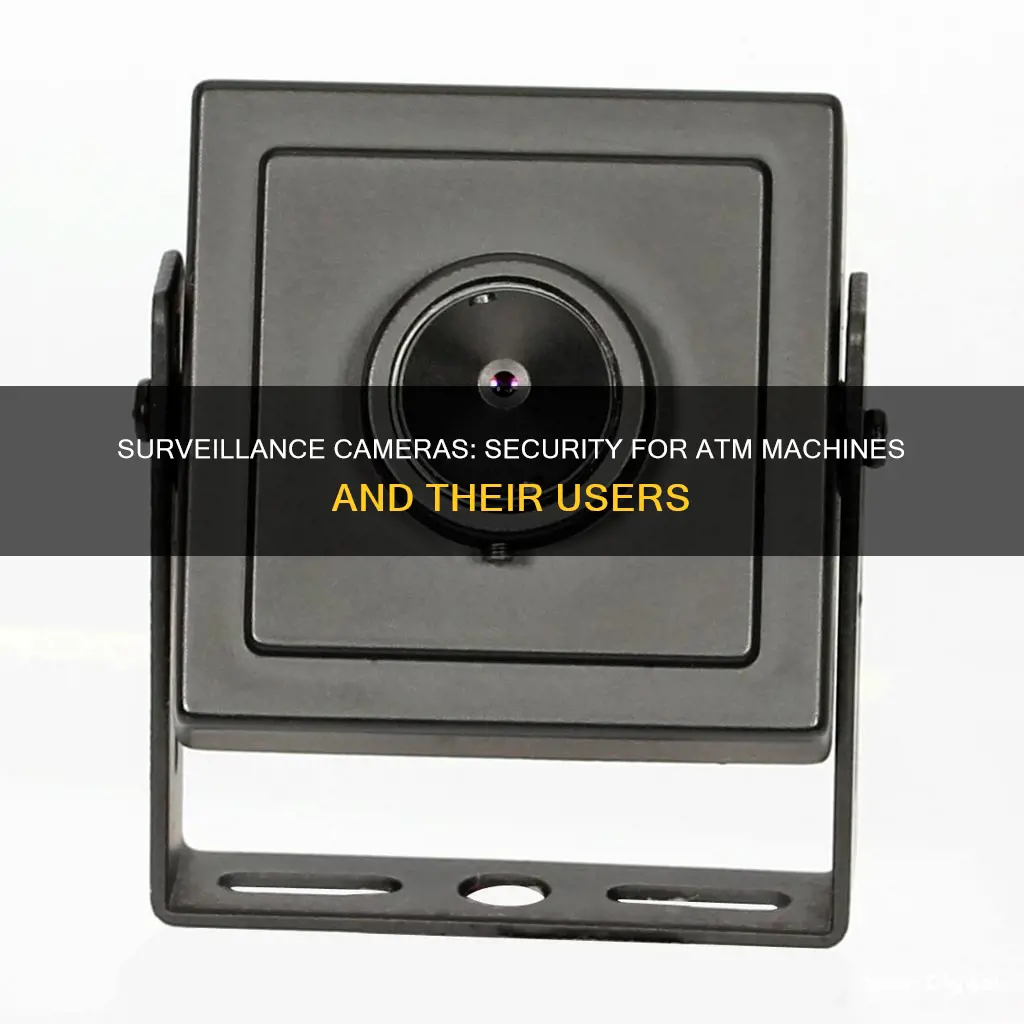
Surveillance cameras are an essential security feature for ATM machines, serving multiple purposes. Firstly, they act as a deterrent to potential criminals, reducing the likelihood of theft and fraud. Secondly, in the unfortunate event of a crime, high-quality cameras can provide clear and valuable evidence to aid investigations and help identify perpetrators. Additionally, real-time monitoring capabilities enable prompt responses to incidents, enhancing the overall security of the ATM and its users. With the rise of ATM skimming and other fraudulent activities, financial institutions recognize the importance of investing in reliable surveillance solutions to protect their assets and customers.
What You'll Learn

Crime prevention and teller protection
Surveillance cameras are an integral part of crime prevention and teller protection at ATM machines. The presence of security cameras acts as a deterrent for potential criminals, reducing the likelihood of customers being approached and victimized. This simple measure can help prevent card theft, cash theft, and ATM skimming, where criminals use devices to record and steal customer card information.
The cameras also provide valuable protection for tellers. In the unfortunate event of a bank robbery, the footage can be used to identify the perpetrators and aid in their capture. This helps to increase the security of bank staff, who are at risk during these crimes. The cameras also act as a deterrent to internal theft, as staff are less likely to attempt any fraudulent activity knowing they are being watched.
The quality of the cameras is important, and banks are advised to invest in good video surveillance systems. High-definition images can be used in forensic investigations to identify suspects, and the clearer the image, the more likely it is that the criminal will be caught. IP cameras, for example, can deliver sharp megapixel images, even in low-light conditions. This technology can also be used to detect suspicious behavior, such as someone lingering at the machine without making a transaction, which could indicate the installation of a skimming device.
The placement of the cameras is also a key consideration. Cameras should be positioned to monitor not only the ATM transactions but also the surrounding area, to capture a comprehensive view of any suspicious activity. In addition, cameras should be placed high enough to avoid tampering and vandalism.
The Evolution of Movie Cameras: Capturing Cinematic Moments
You may want to see also

To prevent ATM skimming
Surveillance cameras are an important tool in preventing ATM skimming, a type of fraud that has increased in recent years. Criminals use skimming devices attached to the card reader to collect card information and drain accounts. To prevent this, modern ATM surveillance systems can detect and respond to attacks in real time. If attackers try to force a terminal, the bank's security service can receive an alarm notification and event footage, allowing them to respond immediately.
Additionally, surveillance cameras can be used to detect and prevent skimming devices from being installed in the first place. For example, if someone tries to cover the ATM security camera or install a hidden camera, the system can send a notification to the bank's security service, who can then take appropriate action. This proactive protection is an essential element of ATM physical security, helping to protect users' card data and prevent skimming attacks.
Another way surveillance cameras prevent ATM skimming is through the use of face detection and recognition technology. This technology can determine if there is someone in front of the ATM during the transaction. If a face is not detected, the ATM will not dispense cash, reducing the risk of fraudulent activity. Face recognition can also be used as a form of authorization, linking the user's face to their transaction. This allows banks to track down individuals involved in fraudulent transactions.
Surveillance cameras also help to simplify access to transaction data during dispute resolution. Photos and videos collected from ATMs are stored on a secure server, allowing banks to easily search for information about any transaction using various parameters such as card number, transaction date, or alarm events. This reduces the response time to disputes and makes it easier for banks to resolve them.
Displaying Camera Raw Data in Adobe Bridge: A Step-by-Step Guide
You may want to see also

To prevent hidden camera installation
Surveillance cameras are an important tool in preventing the installation of hidden cameras at ATMs. Criminals have been known to install small hidden cameras to steal ATM pin numbers, and security cameras can help detect and prevent this. When security cameras are installed at ATMs, they can monitor the machine and its surroundings, making it difficult for criminals to install hidden cameras without being noticed.
The presence of security cameras can also deter criminals from attempting to install hidden cameras in the first place. They know that their actions are more likely to be noticed and recorded, increasing the chances of them being identified and caught. This proactive protection is an important aspect of ATM security.
In addition to deterrence, security cameras can also provide real-time responses to suspicious activities. Modern surveillance systems can be configured to send notifications to the bank's security service or even directly to a mobile phone if any unlawful activity is detected. This includes attempts to cover or tamper with the security cameras themselves, as well as the installation of hidden cameras. With this real-time information, appropriate actions can be taken immediately, such as turning off the ATM to prevent the copying of information or the installation of malware.
To enhance the effectiveness of security cameras in preventing hidden camera installation, it is important to consider the placement and configuration of the cameras. Ideally, the cameras should be positioned to monitor not only the ATM but also its surrounding area, providing a comprehensive view of any suspicious activity. Additionally, the use of high-resolution cameras with features like WDR technology ensures clear and detailed images that can aid in identifying individuals attempting to install hidden cameras.
By utilizing surveillance cameras with advanced features and ensuring proper placement and configuration, banks can significantly improve their ability to prevent the installation of hidden cameras at ATMs. This proactive approach to security not only protects customers' sensitive information but also enhances the overall safety of ATM transactions.
Focusing LG V10 Camera: Tips and Tricks
You may want to see also

To investigate criminal activity
Surveillance cameras are an effective tool in the investigation of criminal activity at ATMs. They provide detailed visual evidence of crimes, enabling investigators to identify suspects and gather valuable information about their behaviour and methods. This helps to accelerate investigations and improve the chances of apprehending criminals.
High-quality, reliable surveillance systems are crucial in this regard. FBI investigators often advise banks to invest in good video surveillance systems and regularly test them to ensure optimal performance. Clear, high-definition images captured by covert IP cameras can be invaluable for forensic investigations. They can also assist in identifying suspicious behaviour, such as individuals loitering around ATMs without conducting transactions, which may indicate the installation of skimming devices.
Additionally, modern video surveillance solutions offer advanced capabilities. Real-time response systems can immediately notify bank security services of attacks, allowing them to respond promptly. Face detection and recognition technologies further enhance security by preventing transactions when a face is not detected and enabling the identification of individuals involved in transactions.
The centralisation of video surveillance data is also beneficial. By storing recorded photos and videos on a secure bank server, rather than locally on the ATM, banks can protect this critical data from theft or loss. This centralised management system simplifies access to video evidence during investigations, reducing the response time and facilitating the resolution of disputes.
To further optimise the effectiveness of ATM surveillance systems in criminal investigations, banks should ensure proper maintenance, regular testing, and the utilisation of advanced technologies such as face recognition and real-time response capabilities.
Charging Camera Batteries: DIY Home Hacks
You may want to see also

To provide customer safety
Surveillance cameras are installed in ATM machines to enhance customer safety. The presence of security cameras acts as a deterrent to potential criminals, making it less likely that customers using the ATM will be targeted. The cameras can also monitor and record any suspicious activity, such as the installation of hidden cameras or skimming devices, and even prevent crimes before they occur. For example, if someone is lingering at the machine without making a transaction, this could be a sign that they are attempting to install a skimming device.
In the unfortunate event of a crime taking place, high-quality security cameras can provide invaluable visual evidence. This helps to identify criminals and accelerate investigations. The ability to quickly search through digital video footage for exact times and dates is a smooth and painless process. This is especially important for ATMs, which are usually left unattended for long periods.
Modern video surveillance solutions can also provide a real-time response to attacks. For instance, if attackers try to force a terminal, the bank's security service can receive an alarm notification and event footage and respond immediately. The system can be set up to notify relevant parties via mobile phone, and a range of responses can be automated, such as closing the doors to the space where the ATM is located and turning off the terminal.
The use of surveillance cameras in ATMs also helps to build trust with customers, as it demonstrates the bank's commitment to providing a safe and secure environment for its customers.
Troubleshooting Camera Auto-Focusing Issues
You may want to see also
Frequently asked questions
Surveillance cameras are an effective way to increase security and protect customers and their transactions.
The presence of security cameras acts as a deterrent to potential criminals. They can also help to identify suspects and accelerate investigations.
ATM surveillance cameras can benefit banks and customers by providing real-time responses to attacks, helping to prevent ATM skimming, and providing valuable data and visual evidence in the event of a crime.
Without surveillance cameras, ATMs are more vulnerable to theft, fraud, and physical attacks. In addition, the lack of video evidence can hinder investigations and make it difficult to identify and apprehend criminals.







